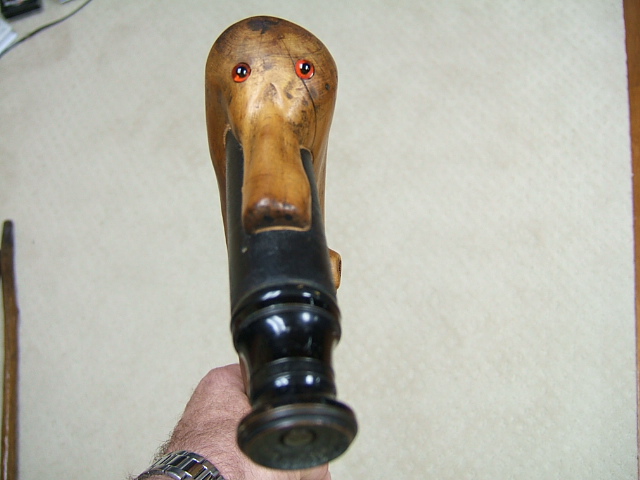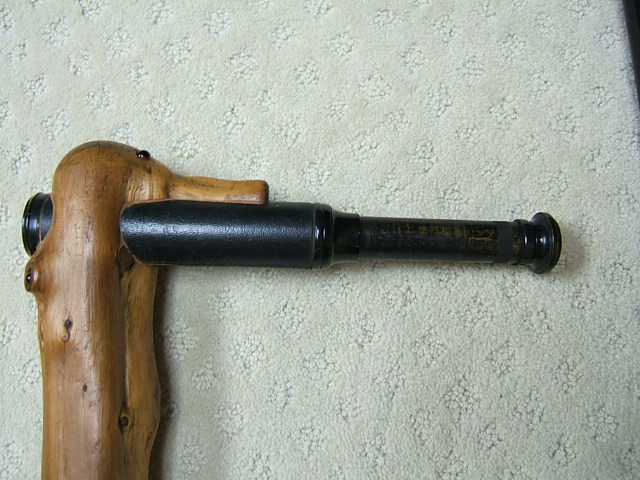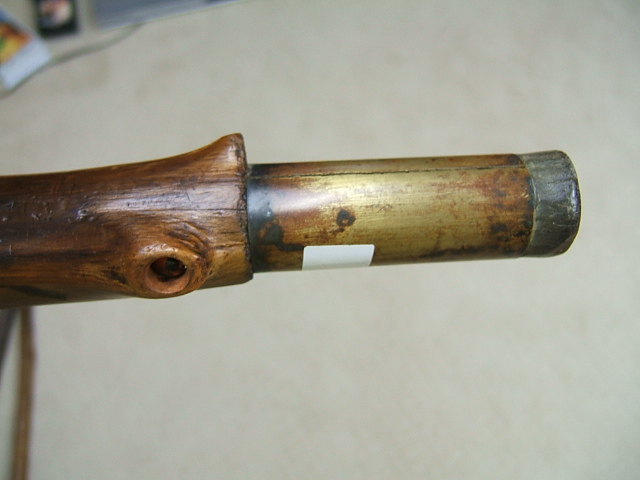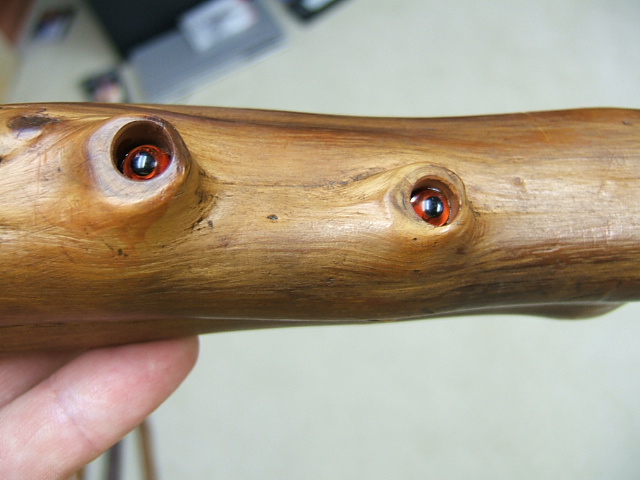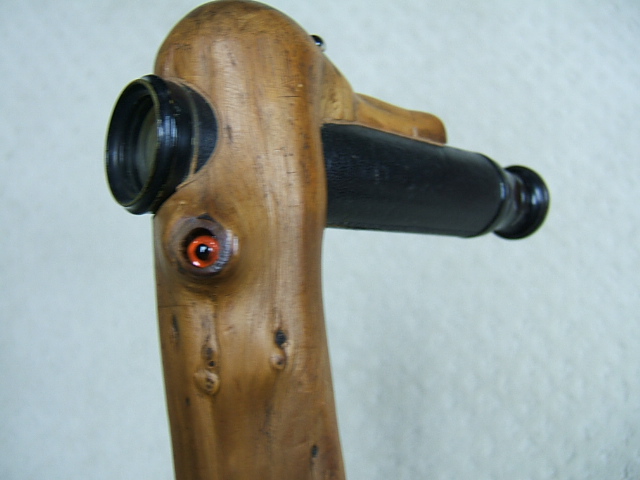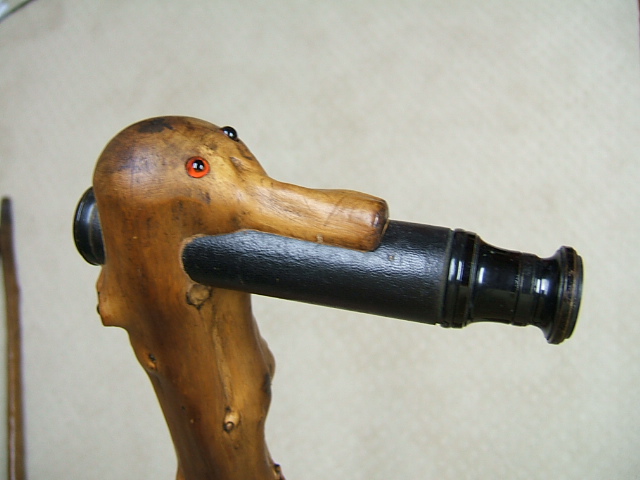 Folkart Telescope (8296) Folkart Telescope (8296)
This massive 2Ē diameter folk art gadget is interesting. The handle looks like a platypus It has glass eyes of an unusual red color with the same eyes peering out from inside the shaft at every knot. The one draw telescope is high power and very unusual as telescopes of this size always have more than one draw. Telescope is circa 1890. It has a great 2Ē+ original brass and steel ferrule. Please forgive me for I have sinned. When I got this cane it was painted all black and was really ugly so I stripped and waxed it. I generally donít like doing that, but it wasnít how it was meant to look. When a piece is painted and it has a beautiful wood beneath it leaves little choice. Any paint and varnish remover will do the job. You paint it on and use #2 steel wool to take off the old finish. There are two types of stripper; liquid and semipaste. The liquid which I used on this cane, is able to work best on ornate surfaces bywashing off thefinish with a brush. I use a tray so I can reuse the stripper for more than one application. I had to get around the glass eyes clean. The semipaste works best on flat surfaces. I never touched the wood with sand paper, which scratches the wood and takes off the 100 year old color beneath. The color beneath, the original ferrule, the hand blown glass eyes, the lack of scratches on the wood, the fit of the telescope are descriptive of age. Sand paper scratches are an indication of lack of good workmanship, which is almost never the case of an antique cane This does bring us to the purpose of this cane. What affect does refinishing have on the value of a cane?. Being in the antique business for almost 40 years, Iíve had that question hundreds of times. You always hear on the antique road show that refinishing hurts the value a lot. What they are talking about is the federal furniture of the 17 hundreds. Very little furniture on the antique market is over 200 years old, the era that is effected by refinishingChippendale, Duncan fife, Hepplewhite, ended before 1800. Starting with Empire in 1815 to 1840, Victorian 1840 to1890, the age of oak 1890 to 1920, Federal revival 1910 to 1940 furniture isnít expensive. . Itís been my experience that most people say they want antiques, but they also want them to look new. As a general rule, the furniture after federal, sells better looking good, which often means refinishing. If the furniture is not originally painted, itís almost always better to refinish. Ugly doesnít sell. . What affect does refinishing have on the value of an antique cane? Iím not sure that it has as much affect on value as it does the number of collectors that wonít buy pieces that arenít original. In the end it may affect value by limiting buyers, but there always seems to people that will buy everything, no matter the quality. This is one of those canes, I donít have an idea what someone would pay for it, it has enough creative and one of a kind qualities that who knows what affect the refinishing would have on it. I paid $200 a number of years ago. In the end its worth what someone is willing to sell it for and what someone else is willing to pay. This is one of those canes thatís best sold at auction, but thatís another story.
Where the line between ugly and original lies, is often drawn too high. In more cases than not finishes should be restored not stripped. The majority of pieces should be Briwaxed. It has a cleaner to take off old wax, a color to make scratches disappear, and fine wax to make the finish shine. In Europe this is the method of choice., America has been slower to endorse this method. It is put on with #2 steel wool, and polished with a soft cloth. For pieces with more severe problems, wash it with murphys oil soap and put a clear finish like spray deft on top. If you donít like how it turns out, you havenít hurt anything. Iíve saved a lot of finishes this way. Another method is to use formbys refinisher. A finish amalgamator. It softens the finish and allows the finish to be moved around, eliminating the need to take all the old finish off and put a new one on. This method is tricky and takes some practice, but it works great. I wouldnít try it on a piece you want to use it on until you have figured it out, although the only down side is you will have to take all the old finish off. It wonít hurt the wood.
If you havenít figured it out everything that works on furniture works on canes. Antique cane world sells Briwax for $20 postage included. Order a tube of simichrome at the same time, the worlds greatest metal polish for silver, copper, brass, aluminum, and gold. It leaves a protective coating so you wonít have to polish as often. Every natural grained shaft should be Briwaxed. Ebonized and ebony shafts should be waxed with Black shoe polish.
Category: Handcarved - Folkart
Sub Category: Wood
Listed: 2006-07-16 22:55:40
|










 Online Video
Online Video




